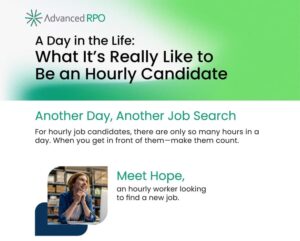Take a Closer Look: What It’s Really Like to Be an Hourly Candidate

An Hourly Candidate’s Reality
The challenges of today’s labor market continue to impact a company’s ability to fully staff their locations. In fact, 76% percent of hiring managers say attracting the right job candidates is their greatest challenge.
While it could be that there just aren’t enough available candidates to fill open hourly roles, it could also be that something in the job search process is creating a roadblock between qualified candidates and roles they would excel in.
Taking a closer look at what hourly candidates go through to get hired can shine a light on areas where businesses could streamline and improve the process. Check out our infographic, What It’s Really Like to Be an Hourly Candidate, and keep reading below for some statistics that put this further into perspective for employers.
Candidates Sound Off
Hope’s experience isn’t unique. Two of her challenges that stand out as being easily preventable are a complicated application process and poor communication from employers.
It’s important to ensure both the application process and the overall hiring process are designed to attract, rather than repel, job seekers. Research tells us that often this isn’t the case.
Making the case for… simplifying the online application process.
Here’s two startling statistics: 60% of job seekers quit in the middle of the online job application process because of length or complexity. Why are so many candidates dropping off?
Maybe it’s because an average of 51 clicks are required to get through an application.

Check out our infographic and learn what it’s really like to be an hourly candidate.
How can employers increase their apply rates? Simplify, simplify, simplify. Employers are getting more applicants by taking the time to streamline and simplify the online application process in the first place. The most obvious benefit of an easier application process is more applicants per role. But there are others, too.
- More applicants means more candidates to choose from, which allows you to hire the best person for the role.
- A great experience for candidates leads to a strong, positive employer brand.
- Meeting more people means adding more talent to your pipeline for future roles.
We recommend employers continually assess their application process to identify opportunities for improvement. Not only is this a best practice generally speaking, but it’s imperative to make it as easy as possible for job seekers in today’s candidate-driven market.
If you haven’t analyzed your application process lately, here is a great way to get started. First, have at least three people (HR and non-HR employees) apply for one of your positions. Provide them with some parameters from which to describe their experience. How long did it take them to complete it? At which points did they get frustrated? What redundancies did they experience? Repeat this process by having these same people complete the application processes for your competitors.
More often than not, talent acquisition leaders are unaware of the frustrations job seekers experience while applying for their roles. Gaining first-hand visibility into the application process will give them a jumping off point from which to simplify and improve the process.
Making the case for… better, and consistent, communication.
The application process itself isn’t the only hurdle hourly candidates face. It’s not uncommon for them to wait an inordinately long time to hear back after they click “apply,” or to be ghosted altogether. 44% of online job applicants wait at least two weeks to hear back from prospective employers, and 48% find these long wait times highly frustrating.
Many hourly candidates need to earn money now, line up a second job, or be able to pursue other positions if the one they applied for doesn’t pan out. Two weeks can seem like an eternity in this situation.
The easiest and most effective way to improve communication with candidates is through established communication cadences. This can be achieved through automated communications in the ATS, or manually by recruiters. Whether it’s acknowledgement of an application or a 24-hour reminder for an interview, recruiters must keep up with candidates while maintaining a personal touch in all phases of the process.
Whether you use automation technology or not, every step of the hiring process requires communication to candidates on what to expect, and what they should do next. This includes everything from interview scheduling to background checks and onboarding documentation. It is critical to keep candidates engaged and informed throughout the entire process.
And, employers need to deliver on what they promise. If you tell a candidate you’ll be in touch in 24 hours, you need to ensure that happens. It’s better to tell them that they will hear from you in three days and communicate earlier vs. getting back in touch a few days after you’ve promised.
Hourly candidates are available one day and gone the next. Two of the biggest, completely preventable mistakes employers make is having a difficult application process and not keeping candidates informed throughout the process. Before you raise your pay rate or think about offering a signing bonus, take a step back and evaluate whether you’re treating candidates how they expect to be treated. Oftentimes, the experience candidates have with you during the application and interview process is as important as the salary, benefits, and work environment you provide once they’re on your payroll.
Gain perspective to improve candidate experience and apply rates
If you haven’t already, take a minute to walk through our infographic and experience an hourly candidate’s reality. See our infographic.
With that perspective in mind, it’s time to look at what you can do to change how your business can deliver better experience and achieve better apply rates. Ready for your next challenge?
